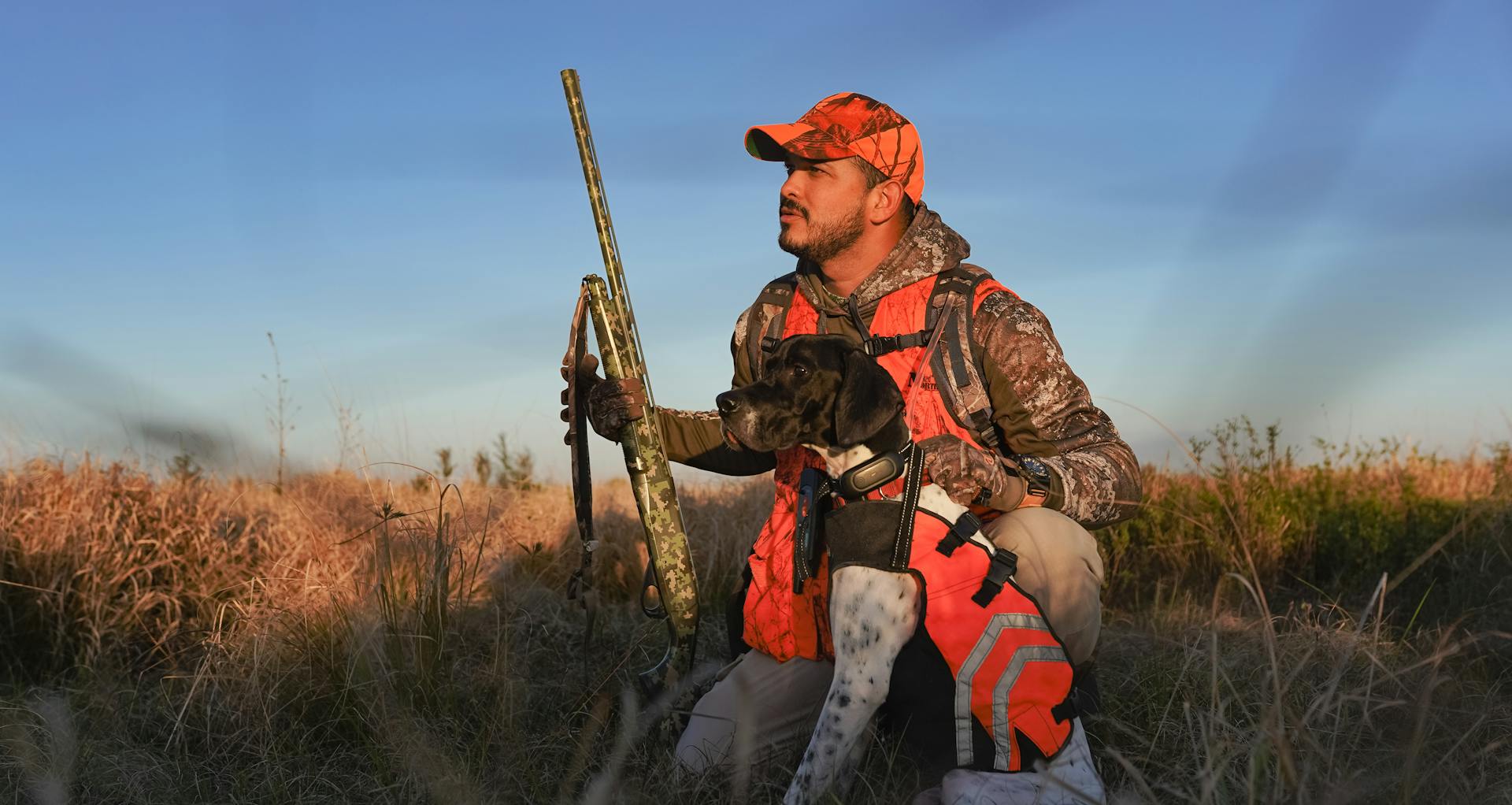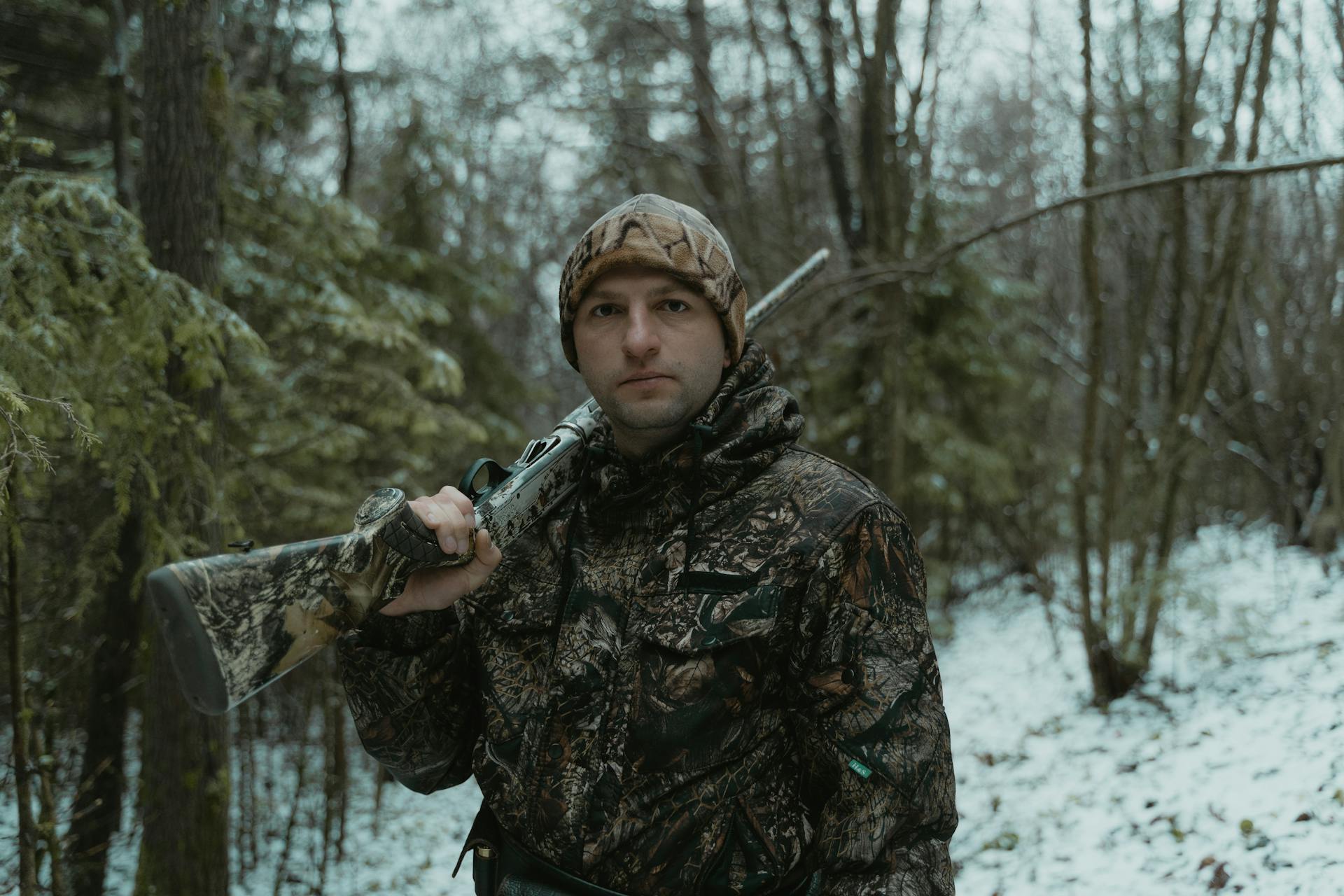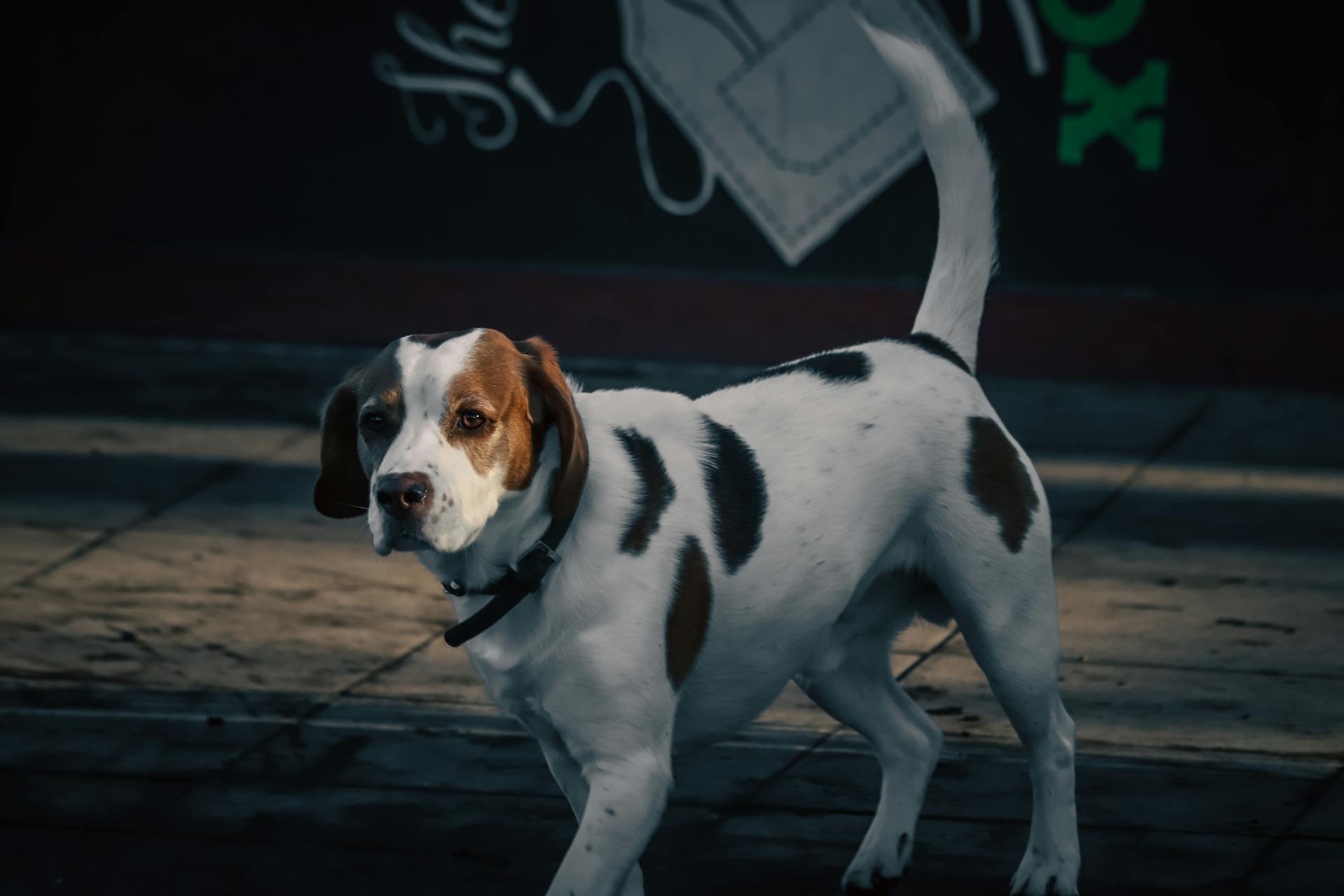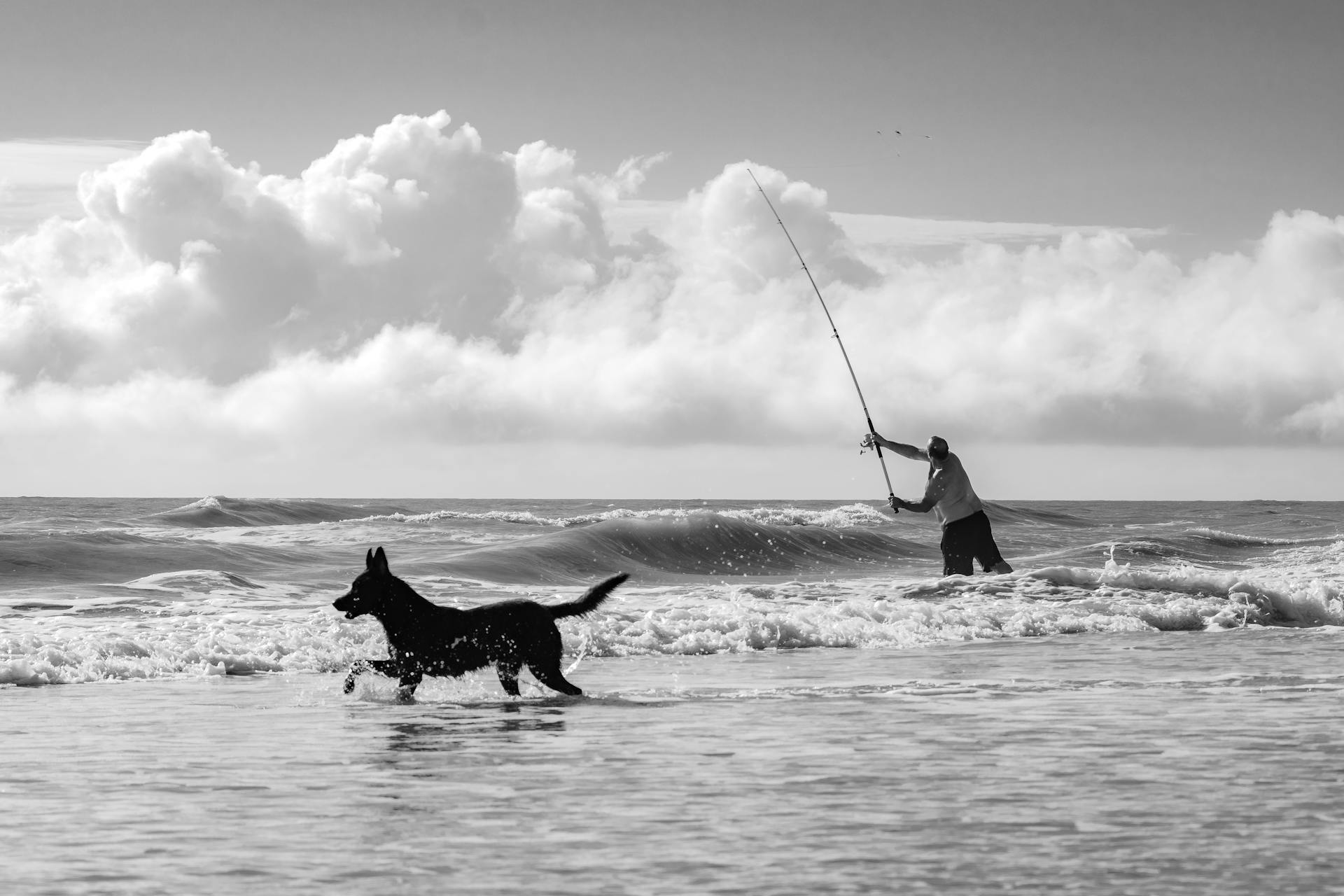
The Bluetick Coonhound is a versatile and energetic breed that's perfect for active families or hunters. They're native to the southern United States, specifically the Appalachian region.
Originally bred to hunt small and large game, Bluetick Coonhounds are natural-born trackers with a strong prey drive. Their keen sense of smell and endurance make them well-suited for this task.
Blueticks are known for their distinctive blue and white ticking on their coat, which is a result of the breed's unique genetics.
Physical Characteristics
The Bluetick Coonhound is a handsome dog with a unique tri-colored coat. Their coat is typically dark blue-gray with black spots on their back, ears, and sides.
Their ears are thin, floppy, silky, and set low on the head. The ears are predominantly black, as is the head.
The Bluetick Coonhound has a broad head with a domed skull. Some dogs can have tan markings around the eyes, cheeks, chest, and below the tail.
Consider reading: Smooth Coat Fox Terrier Puppies
Their eyes are large, wide-set, and dark brown. They have beautiful pleading eyes that are round and colored a dark brown.
Their tail is carried high and tapers to a fine point. Their long, muscular hind legs and compact feet with well-arched toes make them a distinctive dog in appearance.
Their fur is normally short and glossy. The coat is dark blue in color, with black spots on the back, ears, and sides, giving them a distinctive "ticked" appearance.
On a similar theme: Bull Terrier Eyes
Care
Taking care of your Bluetick Coonhound is a big responsibility, but with the right approach, it can be a breeze.
Bluetick Coonhounds require lots of activity to be happy and healthy dogs, so make sure to provide them with plenty of exercise. This can be as simple as a walk around the block or a game of fetch in the backyard.
Their grooming needs are fairly easy to manage, with occasional brushing of the coat to keep it shiny and clean. They are also low droolers, but may need the occasional face wipe to save the furniture or your clothes.
Here are some key things to keep in mind when it comes to caring for your Bluetick Coonhound:
- Brush their coat at least weekly to keep it shiny and clean.
- Brush their teeth at least once a week, or more often if you can.
- Clean their ears weekly to prevent infection.
- Trim their nails as needed, but a busy dog like the Bluetick Coonhound may wear them down on their own.
- Feed a high-quality diet appropriate for their age, and avoid giving them people food.
- Exercise them regularly, but don't overdo it at first.
By following these simple tips, you can help your Bluetick Coonhound live a long, happy, and healthy life.
Health
Taking care of your Bluetick's health is crucial to ensure she lives a long, happy life. Brushing her teeth daily will prevent periodontal disease.
Bluetick Coonhounds are prone to certain health issues, including gastric dilatation and volvulus. This condition can be life-threatening, so it's essential to be aware of the signs and symptoms.
To prevent accidents, supervise your pet as you would a toddler. Keep doors closed, pick up after yourself, and block off rooms as necessary.
Grooming needs are relatively low for Blueticks. Brush her coat as needed, at least weekly, to keep her looking her best.
Regular ear cleaning is crucial, especially for dogs with floppy ears like Blueticks. Clean her ears weekly, and make sure to keep them dry.
Discover more: Miniature Bull Terrier Life Span
A consistent diet and regular exercise are vital for maintaining your Bluetick's physical and mental health. Feed a high-quality diet appropriate for her age, and exercise her regularly, but don't overdo it at first.
Here are some essential health tips for Blueticks:
- Brush your dog's teeth at least twice a week to keep them perfect.
- Clean her ears weekly to prevent infections.
- Keep her diet consistent and don't give her people food.
- Exercise your dog regularly, but don't overdo it at first.
- Always walk your Bluetick on a leash, as she has a tendency to run off after interesting smells.
Training and Behavior
Training a Bluetick Coonhound requires patience and consistency, as they can have a stubborn side. They respond well to positive training methods and socialization from a young age.
Socialization is key to helping your Bluetick feel comfortable and confident around different people, other dogs, and locations. This can help prevent problematic behaviors, such as excessive baying.
To manage their strong hunting instinct, it's essential to keep them leashed in unconfined areas and monitor their behavior around cats and other small pets. With proper training and socialization, you can reduce their less desirable traits and make them an excellent family dog.
Breed Group
The Bluetick Coonhound is a Hound breed, which tells us a lot about its behavior and needs.
As a Hound, this breed is bred for hunting and tracking, so they have a strong prey drive and love to follow their nose.
If you're wondering what breed your dog is, you can check out Wisdom Panel's DNA tests to find out.
Training
Training your Bluetick Coonhound requires patience, consistency, and positive reinforcement. Positive training methods are essential to help your dog develop good manners and a strong bond with you.
Start training your puppy as early as possible, ideally from a young age, to prevent unwanted behaviors from developing. Blueticks that don't receive enough attention might develop problematic behaviors, including excessive baying.
Consistency is key when training your Bluetick. Enroll in an obedience class as soon as you're able to help your dog learn good manners and strengthen your bond. They can be a handful to train, often getting distracted by interesting scents.
Firmness and patience are necessary to achieve the desired results. Blueticks have a strong hunting instinct, which can sometimes lead to distractions. They require a strong owner who is the pack leader.
Socialization is equally important to training. Expose your dog to different people, other dogs, and various locations to boost their comfort and confidence. This will help your Bluetick become friendly and welcoming of strangers.
Proper training and socialization can mitigate some of the less-desirable traits of the Bluetick breed. With consistent training and socialization, your Bluetick will grow into a loyal and loving companion.
Adopt/Buy
If you're looking to bring a bluetick coonhound into your life, you've got two main options: adopt or buy.
Adopting a bluetick coonhound can be a wonderful way to give a loving home to a dog in need.
The cost of buying a breeder puppy can vary widely, but on average, you can expect to pay around $1,000.
Local animal shelters and breed-specific rescue groups often have bluetick coonhounds waiting for a forever home.
For more information, you can check out the National Bluetick Coonhound Association, Bluetick Breeders of America, or Bluetick Coonhound Rescue.
Here are some resources to help you get started:
- National Bluetick Coonhound Association
- Bluetick Breeders of America
- Bluetick Coonhound Rescue
Comparison and Considerations
If you're considering bringing a Bluetick Coonhound into your family, it's essential to weigh the pros and cons. These dogs are known for being sweet and loyal, which makes them a great addition to many households.
One of the benefits of owning a Bluetick Coonhound is that they require low grooming maintenance. This means you won't need to spend a lot of time brushing their fur or dealing with matting issues.
However, it's also important to consider the potential health issues that can arise in these dogs. Changes in appetite or water consumption, tartar build-up, and itchy skin are all symptoms that could indicate a serious disease.
Here are some key factors to consider when deciding if a Bluetick Coonhound is right for you:
- Appetite and water consumption changes
- Tartar build-up, bad breath, red gums, or broken teeth
- Itchy skin (scratching, chewing or licking), hair loss
Key Considerations
If you're considering bringing a Bluetick Coonhound into your family, there are several key considerations to keep in mind. They require a lot of activity and mental stimulation to avoid boredom vices.
A Bluetick Coonhound is a highly active breed that needs a full-time job, which can be a challenge for some owners. They are extreme hunting dogs developed for raccoon and small game hunting.
To ensure your Bluetick Coonhound stays happy and healthy, schedule routine checkups to catch any potential health concerns early, such as hip dysplasia and cataracts. They generally have an average life span of 11-12 years.
If you're an experienced dog owner, you'll appreciate the low grooming maintenance of a Bluetick Coonhound. They typically require minimal grooming, which is a plus for busy owners.
Here are some key characteristics to consider when deciding if a Bluetick Coonhound is right for you:
- Lovable, playful companion
- Highly active and eager to have a purpose
- Alert, curious, and busy
- Good with children
- Requires minimal grooming
- Excellent hunting dog
Similarly Sized Breeds
If you're considering bringing a Bluetick Coonhound into your family, you might also want to look into breeds of similar size.
The Golden Boxer, for example, is about 98% similar in size to the Bluetick Coonhound.
Pointers, like the Pointer Bay, are also a good match in terms of size.
Collies, such as the Collie, are another breed that's roughly the same size as the Bluetick Coonhound.
Other breeds worth considering are the Huskita and the Cesky Fousek, both of which are about 98% similar in size to the Bluetick Coonhound.
Here are some breeds that are similar in size to the Bluetick Coonhound:
- Golden Boxer (98% similar)
- Pointer Bay (98% similar)
- Collie (98% similar)
- Huskita (98% similar)
- Cesky Fousek (98% similar)
Cons
If you're considering bringing a Bluetick Coonhound into your family, it's essential to be aware of some potential downsides. They can be very vocal, so be prepared for a lot of barking.

Their independent nature can make them stubborn and challenging to train. Consistency and patience are key when working with this breed.
Bluetick Coonhounds need lots of exercise to stay happy and healthy. They require regular physical activity to prevent boredom and destructive behavior.
Here are some specific characteristics to consider:
- Very vocal
- Stubborn and challenging to train
- Needs lots of exercise
Frequently Asked Questions
What breeds make a blue tick?
The Bluetick Coonhound is a cross between several breeds, including the Grand Bleu de Gascogne, English Foxhound, cur dog, American Foxhound, and Black and Tan Virginia Foxhound. This unique blend of breeds gives the Bluetick Coonhound its distinctive characteristics and traits.
Sources
- https://www.thesprucepets.com/bluetick-coonhound-dog-breed-profile-1117911
- https://www.wisdompanel.com/en-us/dog-breeds/blue-tick-coonhound
- https://wagwalking.com/breed/bluetick-coonhound
- https://www.thepethealthclinic.com/client-resources/breed-info/bluetick-coonhound/
- https://wahlusa.com/pet-grooming/product-selector/dog/bluetick-coonhound
Featured Images: pexels.com


